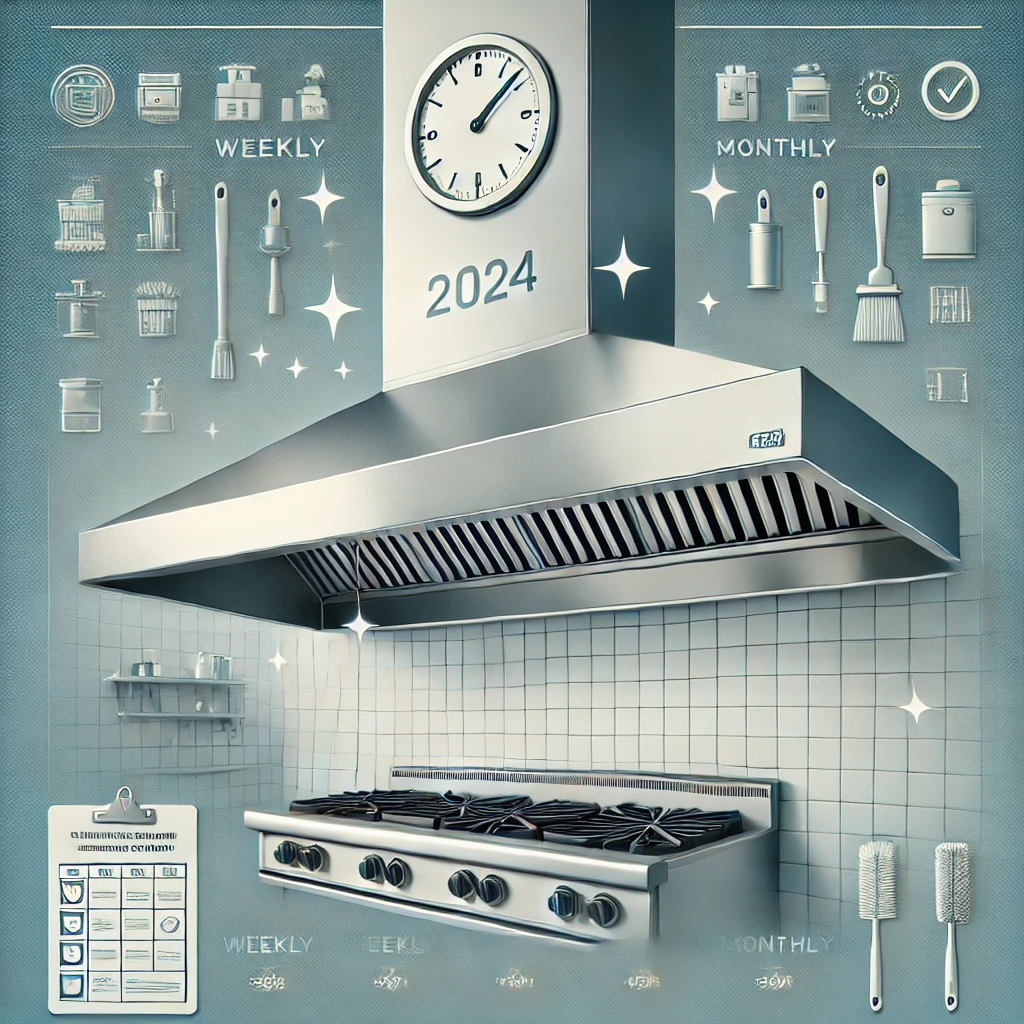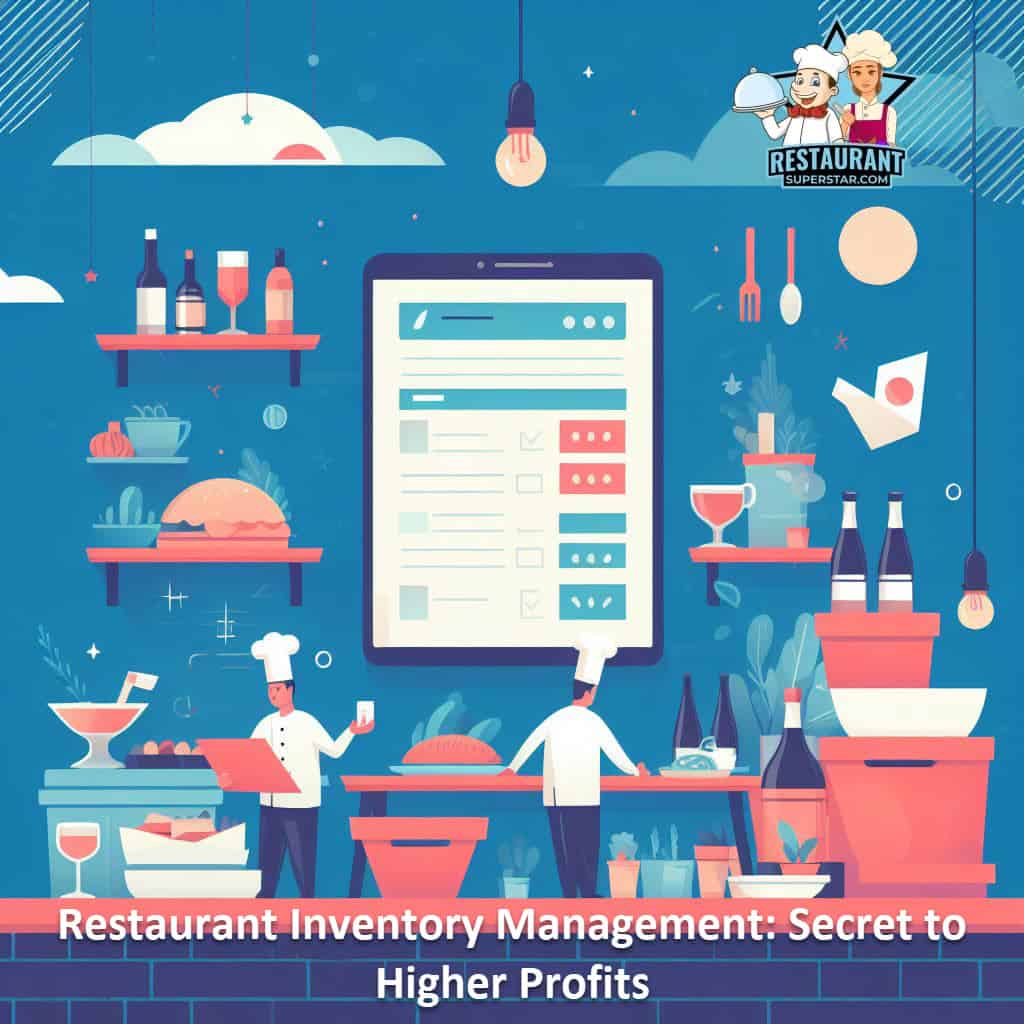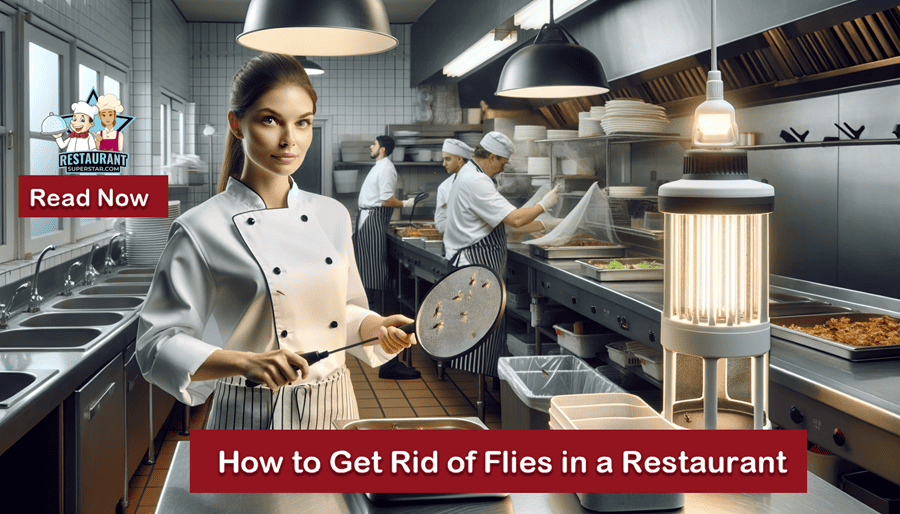Easiest Way to Fill Portion Cups for a Restaurant
You’re in the Right Place if You’re Wondering About the Easiest Way to Fill Portion Cups for a Restaurant
Hey there,
It’s Jeff from sunny Florida; as a seasoned restaurant consultant, I’ve been around the block a few times when perfecting daily restaurant tasks.
And trust me, if you’re here, scratching your head about the easiest way to fill portion cups for a restaurant, you’re not alone.
But guess what? You’ve landed on the right page.
This article will unravel this mystery for you and a few others that might pique your interest.
Let’s dive right in, shall we?
Easiest Way to Fill Portion Cups for a Restaurant
Easiest Way to Fill Portion Cups for a Restaurant? Now, if I were to boil down the gist of it into a bite-sized chunk, I’d say: The simplest method is manual filling with tools like ladles or measuring cups. But for high-volume restaurants or those seeking precision, dispensing lids or automated machines might be the way to go.
Curious about the nitty-gritty details?
Well, there’s plenty more where that came from.
But hold on a second because things will get even more exciting.
As we navigate this article, we’ll deep-dive into each method, uncovering the pros, cons, and some personal tips I’ve picked up.
Whether you’re running a cozy diner or a bustling eatery, there’s something here for everyone.
Why Efficient Portion Cup Filling is a Game Changer
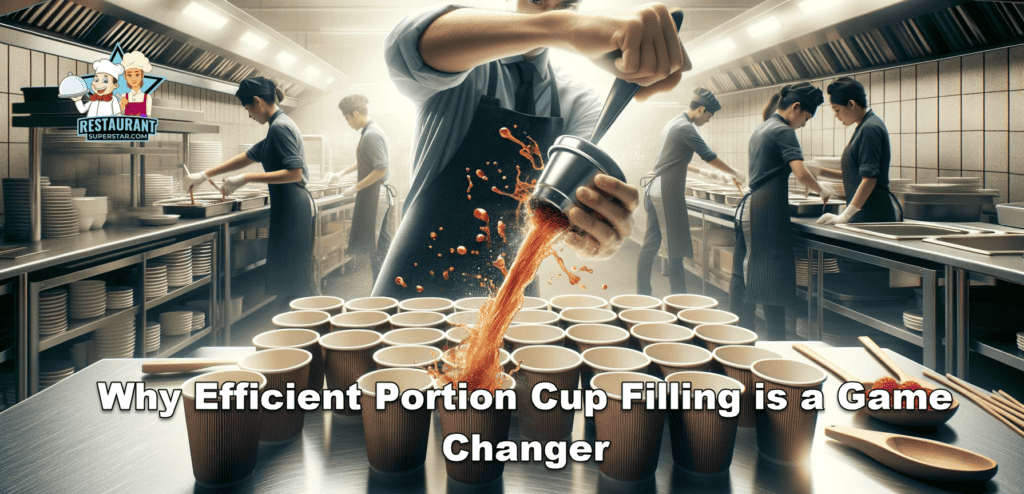
If you’ve ever worked behind the scenes at a restaurant, you’ll know that every second counts.
Time wasted is money lost, and efficiency can be a real game changer in the fast-paced world of gastronomy.
Now, let’s talk portion cups. These little containers, whether holding your favorite salsa, some tangy dressing, or even the gravy that gives life to your mashed potatoes, play a pivotal role in customer experience.
Getting the portion right ensures consistency in flavor, presentation, and all-important cost efficiency.
But here’s the thing – not all portion cup-filling methods are equal.
The Many Ways to Fill a Portion Cup
Back in my early days, I’ve seen folks use everything from spoons to their bare hands (yikes!) to fill portion cups.
Over time, various innovative methods emerged as the industry evolved and the demand for precision grew.
Some restaurants swear by manual filling, while others only dream of portioning with trusty automated machines.
The kind of difference the right tools and techniques can make is fascinating.
The Old-School Charm of Manual Filling
Ah, manual filling. It takes me back to my younger days, working my first gigs in the restaurant industry here in Florida.
The sun was always shining, the beaches were a stone’s throw away, and in the kitchens, we filled those portion cups by hand.
It’s an age-old method, and while it may have flaws, there’s a certain charm. Let me break it down for you.
What Exactly is Manual Filling?
In its simplest form, manual filling is exactly what it sounds like. You’ve got your portion cups lined up, your food product ready to go, and you – or one of your trusty team members – get down to filling each cup, one by one.
No fancy machines, no high-tech gadgets, just good old-fashioned handiwork.
Tools of the trade
While this method is pretty straightforward, you still need the right tools to do the job well. A ladle or a measuring cup will usually be your best friend.
A ladle works wonders if you’re portioning out a creamy dressing or a luscious sauce.
On the other hand, for more liquid items, a measuring cup ensures you get just the right amount in each portion cup without overflows or wastage.
Pros of Manual Filling
Affordability: One of the biggest pros of manual filling? It’s undeniably affordable. No need to invest in expensive machinery or gadgets.
Especially for smaller restaurants or startups that are just finding their footing, manual filling can be a cost-effective way to ensure customers get consistent portions without breaking the bank.
Cons of Manual Filling
Time and Consistency: But, as with most things in life, there’s a flip side. Manual filling can be a tad time-consuming.
If you’ve got a line of hungry customers waiting, manually filling dozens or even hundreds of portion cups can feel like an eternity. And then there’s the issue of consistency.
Even the steadiest of hands can falter, leading to one cup being slightly fuller than the next.
This can be a potential hiccup for establishments that pride themselves on delivering the same experience to every customer.
Portion Cups with Dispensing Lids – The Modern Marvel
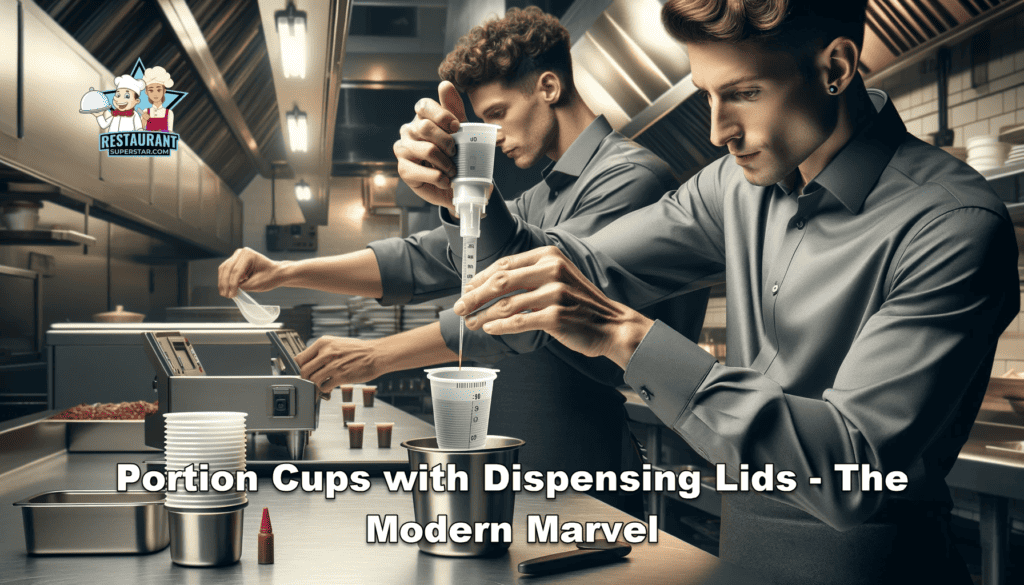
Suppose manual filling is the classic vinyl record of portioning. In that case, portion cups with dispensing lids are the restaurant’s sleek, modern Bluetooth speakers.
A little innovation can go a long way in making life more accessible; these specialized cups are a testament to that. Let’s dive into the wonders of these nifty little containers.
Getting Acquainted with Dispensing Lids
Imagine a regular portion cup, but with a twist—literally. These cups come with built-in dispensers. Think of them as the self-serve drink machines but for your salsas, dressings, and more.
The lid is designed in such a way that it aids in filling the cup. When you press or twist, the dispenser releases the content, ensuring a consistent amount every time.
It’s innovation at its best, blending simplicity with efficiency.
How to Use Them: A Quick Guide
- Preparation: Before you start, ensure the food product you want to portion is compatible with the dispenser. Some might work better with liquid items, while others might be great for thicker sauces.
- Fill ‘er Up: Pour your food item into the dispenser part of the cup, ensuring that the cup evenly.
- Dispense and Seal: Press or twist the lid as per the design. As you do this, the content will fill the cup beneath. Once filled, seal the cup, and you’re good to go.
Pros of Portion Cups with Dispensing Lids
Speed and Precision: The major advantage? These cups are fast. You can quickly churn out portion after portion without breaking a sweat.
Plus, thanks to the design, the amount in each cup is nearly identical, ensuring improved accuracy. Say goodbye to the inconsistent woes of manual filling.
Cons of Portion Cups with Dispensing Lids
Pricier than Their Simpler Counterparts: However, as with most things that make our lives more convenient, there’s a price tag attached. Portion cups with dispensing lids are more expensive than your regular portion cups.
The costs can add up for restaurants that use vast amounts of these. It’s a classic case of weighing the benefits against the investment.
Portion cups with dispensing lids are a fabulous middle ground between manual filling and more advanced machinery. They bring speed and precision but at a slightly higher cost.
Suppose you’re in a setting where time is of the essence, and you’re looking for that sweet spot of efficiency without the hefty investment of machinery. In that case, these might be your new best friend.
Stay with me as we explore more methods, each with unique charm and challenges. The world of portion cup filling is full of surprises!
Stepping Up the Game: The Magic of Portion Dispensers
From sunny Florida, I’ve enjoyed traveling and consulting for restaurants nationwide.
And occasionally, I come across tools that make me think, “Wow, that’s a game-changer!” Portion dispensers fall right into that category.
Suppose you’ve ever been mesmerized by the efficiency of a barista whipping out shot after shot of espresso.
In that case, you’ll get why I’m so enthused about these gadgets.
Let’s dive deeper.
A Quick Intro to Portion Dispensers
When manual filling feels too old-school, and portion cups with dispensing lids don’t quite cut it, enter the world of portion dispensers.
These devices are designed explicitly for one mission: to fill portion cups quickly, consistently, and accurately.
We’re talking about taking the guesswork out of the equation and getting to precise business.
The Hopper and Dispensing Mechanism – The Heart and Soul
At the core of a portion dispenser is its hopper, a container-like section where you load up the food product you want to dispense.
It’s like the reservoir holding your precious cargo, a creamy ranch dressing, or a spicy salsa.
From the hopper, the magic moves to the dispensing mechanism. With a push of a button, pull of a lever, or even a foot pedal in some advanced models, the dispenser releases the exact amount of the product into your waiting cup.
The mechanism ensures that the same quantity is dispensed every single time, making it a dream for those seeking consistency.
PROS: High-Volume Restaurants and Spot-On Accuracy
For bustling restaurants with constant orders, portion dispensers are nothing short of a blessing.
Speed combined with accuracy makes them ideal for such high-volume settings. Every second saved in the kitchen translates to happier customers and smoother operations.
The accuracy part?
Oh, it’s a thing of beauty!
Knowing that every portion cup has the exact amount ensures customer consistency and helps inventory management and cost calculations.
CONS: Your Wallet Might Feel It
While singing praises, it’s only fair to mention the potential hiccup. These devices come with a price tag.
Depending on the model, brand, and features, portion dispensers can be a significant investment.
Evaluating their efficiency and precision is crucial to balance out their cost, especially for smaller establishments or those just starting.
Essentially, portion dispensers are a fantastic tool for restaurants prioritizing speed and accuracy. While the initial investment might be steeper, the long-term benefits often justify the cost.
As we venture further into portion cup filling, remember your restaurant’s unique needs and circumstances. And as always, stay tuned for more insights and tips from sunny Florida.
Automated Machines – The Future of Portioning
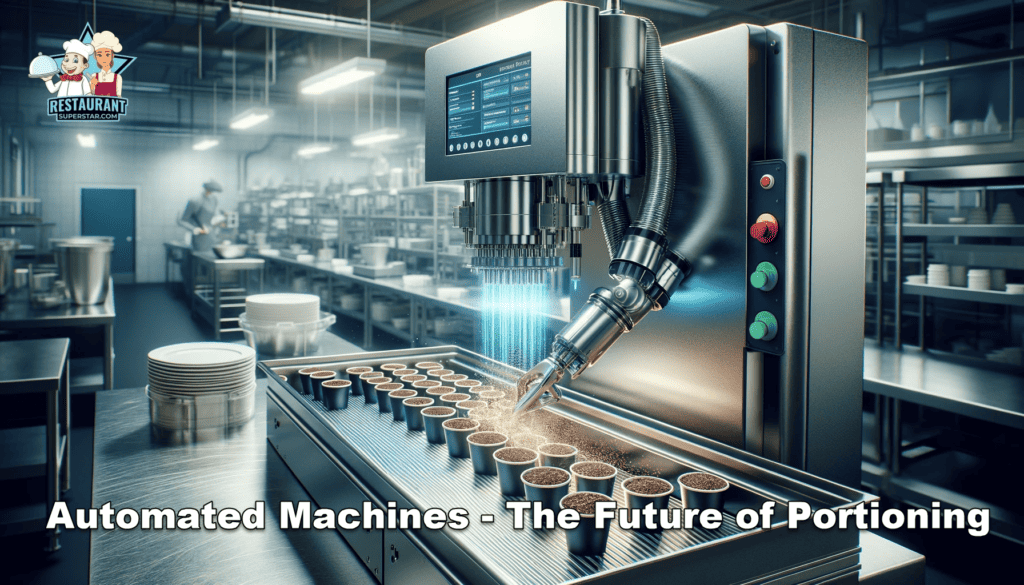
There’s something undeniably exhilarating about the sheer pace and efficiency of the restaurant world.
From the sizzling grills of Miami to the bustling eateries of Orlando, I’ve seen kitchens that run like well-oiled machines.
And speaking of machines, let’s chat about the crème de la crème of portioning: automated portioning machines.
Demystifying Automated Portioning Machines
Picture this: a space-age gadget that looks like it was plucked straight out of a sci-fi movie, but it’s in your kitchen. That’s the vibe of automated portioning machines.
These aren’t just dispensers; they’re complete systems designed to handle the portioning task from start to finish with minimal human intervention.
You load them up, set your parameters, hit start, and watch the magic unfold. They’re the epitome of “set it and forget it.”
The Genius Technology: Precision is the Name of the Game
Behind the sleek exterior of these machines is a combination of cutting-edge sensors, advanced programming, and meticulous engineering.
Many of these machines use technologies like weight sensors or volume measurements to ensure each portion is exact to the gram or milliliter.
You can often program them for different portion sizes, making them adaptable to various menu items.
Some high-end models even have self-cleaning features or adaptability to handle liquid and solid foods.
PROS: Speed and Accuracy Like Never Before
When I say these machines are fast, I mean lightning-fast. They are undoubtedly the quickest method of filling portion cups.
For large-scale restaurants, catering services, or events, automated machines can handle vast volumes in a fraction of the time other methods would take.
And let’s talk accuracy. With automated portioning machines, human error is virtually eliminated.
Every portion cup that comes out is identical to the last, ensuring consistent customer experiences and simplifying inventory management.
CONS: Digging Deep into Your Pockets
As with most high-tech solutions, there’s a cost associated, and it’s substantial. Automated portioning machines represent a significant investment.
They’re the priciest option on our list. While the benefits are numerous, assessing whether they align with your restaurant’s budget and needs is essential.
In a nutshell, automated portioning machines are a peek into the future of efficient restaurant operations.
While they might only be for some, especially smaller establishments or those on a tighter budget, they’re an incredible asset for places where high volume meets the need for precision.
As we journey through the ins and outs of portioning, consider what’s best for your unique setup and goals.
Tips for Efficient Portion Cup Filling
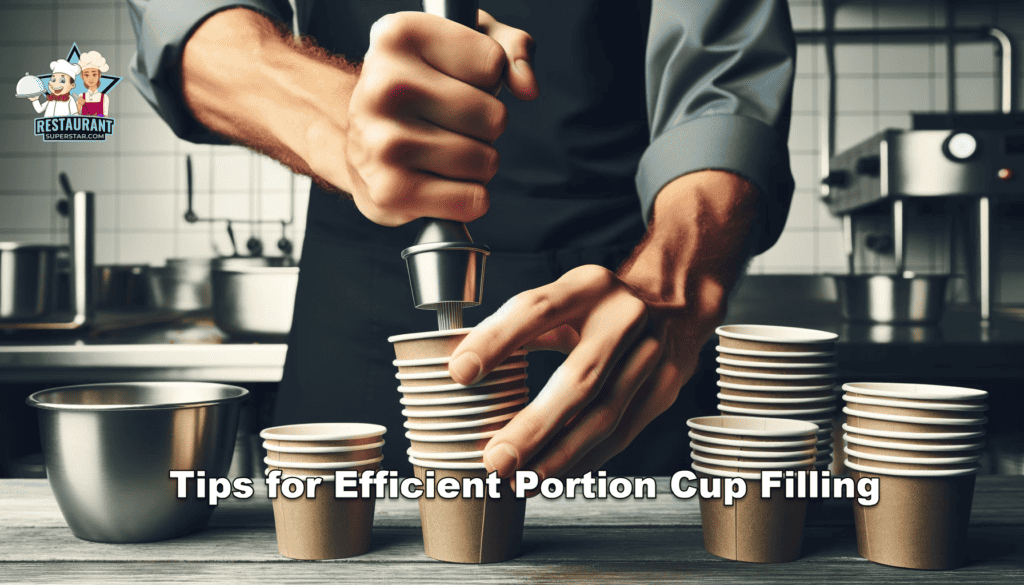
It’s not just the tools that make a difference but also the tiny tweaks and best practices we adopt. The beauty lies in the details.
From the smallest café in Key West to the most happening diner in Tampa, there’s a universal need to be efficient, minimize waste, and maximize consistency.
So, let’s talk tips straight from the heart of Florida.
Varied Portion Cup Sizes – The Power of Choices
Every restaurant will have dishes that range from light, delicate sauces to hearty, chunky sides. Using the same portion cup for everything? That’s like wearing flip-flops to a formal dinner.
It’s essential to have a variety of portion cup sizes at your disposal. Different sizes ensure you’re not overfilling for some items or underfilling for others. Plus, it gives a better visual appeal to the customer. Remember, presentation matters.
Labeling: Why and The How
Have you ever had that mini heart attack moment when you mistook the sugar for salt? Labels are lifesavers! Especially in a busy kitchen where every second counts.
Why label? To prevent mix-ups, ensure consistency, and speed up the service. Imagine not having to second-guess every portion cup you grab.
How to label? Go for clear, legible labels mentioning the type of food and the portion size. Waterproof labels can be a boon, especially for sauces and liquids. And if you’re feeling fancy, color-coding can be a swift way to differentiate at a glance.
Store Smart: Best Practices for Portion Cup Storage
Florida’s humidity taught me one thing: proper storage is vital. Keep your portion cups in a cool, dry place.
Moisture can compromise the integrity of the food, especially dry items. Stacking cups? Ensure they’re appropriately sealed to prevent contamination.
And if you can, allocate a specific area in your kitchen just for portion cups – it’ll streamline your operations like a charm.
Minimize Waste and Maximize Freshness
We all hate waste, both for the environment and the pocketbook. Instead of mass-filling portion cups at the start of the day, consider a demand-driven approach. Fill cups as orders come in or in smaller batches.
This ensures the food stays fresh and reduces the chances of leftover cups at the end of the day.
And if you’re thinking, “But Jeff, what about speed?” With the right tools and practice, you can have both efficiency and minimal waste!
As we wrap up our portion cup journey, remember that the simplest strategies can sometimes bring the most significant changes.
It mixes the right tools, techniques, and a sprinkle of sound old Florida wisdom.
Whether you’re a seasoned chef or just starting in the restaurant biz, these tips are the golden nuggets that can set you apart.
Happy portioning, and if you’re ever around the Florida coast, let’s share a meal and some tales.
Tips Tailored to Different Types
Navigating the world of restaurant portioning, I’ve realized that not all foods are created equal – at least, not when filling those portion cups.
Just like you wouldn’t fish in the Everglades without the right bait, you shouldn’t tackle portioning without tailored strategies.
Let’s dive deep into the specifics, from the saucy wonders to the crispy delights. Gear up for some Floridian flavor tips.
Sauces and Dressings: Smooth Sailing with Funnels
Sauces and dressings can take a dish to culinary nirvana or… end up looking like a hot mess, just like the aftermath of a Florida thunderstorm, you know?
The Funnel Factor: Using funnels when filling portion cups with sauces and dressings is a game-changer.
It channels the flow, reduces wastage, and ensures you get the right amount in each cup. Plus, it’s way faster than trying to aim freehand.
Avoid the Mess: Spills can be slippery, dangerous, and painful. And let’s be honest, in a fast-paced kitchen, nobody’s got time for that. By using a funnel, you’re keeping things neat, tidy, and hazard-free.
Solid Foods
When it comes to solids, precision is crucial. You don’t want one customer getting a mountain of croutons and another just a molehill!
Scoop it Right: For solid foods, scoops are your best friends. They help in picking up consistent amounts each time.
Think of it like building sandcastles at the beach – you want the right tool to get that perfect shape.
Some Solid Examples: Cheese that perfectly melts over nachos, crispy croutons that add that crunch to salads, and tempting toppings that make desserts dazzle. For all these, a scoop ensures you get just the right amount every time.
Liquid Foods: Measure Twice, Pour Once
Liquids can be tricky. Too much and it’s a flood; too little and a drought. Balance is the name of the game.
The Magic of Measuring Cups: These are the unsung heroes of the kitchen. When dealing with liquid foods, a measuring cup ensures you’re portioning out just the right amount. It’s like mixing a cocktail – you want the proportions spot on!
Liquid Legends: Think of that heartwarming soup on a rainy day or the spicy chili that’s a hit at every party.
For these, precision is vital. You wouldn’t want one guest slurping down a hearty bowl while another’s left wanting, right?
Each type of food brings challenges, but with these tailored tips, you’re all set to conquer the kitchen. Remember, it’s not just about filling cups; it’s about crafting experiences.
Whether nestled in a Miami eatery or cooking up a storm in Jacksonville, the proper techniques make all the difference.
Cheers to delectable portioning, and hey, next time you’re enjoying the Florida sun, drop by, and we can share some portioned delights and stories.
Wrapping Up the Portioning Adventure
And just like that, we’ve journeyed through the intricate lanes of portioning for restaurants.
It’s incredible how something seemingly simple, such as filling portion cups, can make a massive difference in restaurant operations.
Let’s take a quick stroll down memory lane:
The Right Filling Method Matters: Whether you’re a charming beachfront café in Miami or a bustling steakhouse in Orlando, the method you choose for filling portion cups can be a bottleneck or a smooth-flowing stream.
Efficient portioning can elevate customer experience, ensure consistency, and, yes, even save you a few bucks in the long run.
Making the Perfect Choice: Every restaurant has its rhythm – its unique pace, volume, and budget.
Some might find solace in the simplicity of manual filling. In contrast, others might need the precision and speed of automated machines.
It’s all about finding that sweet spot that aligns with your restaurant’s needs and budget.
To my fellow restaurateurs, remember that every detail counts whether you’re just starting or have been in the game for decades.
And when it comes to portioning, it’s not just about filling cups; it’s about ensuring every customer gets the perfect taste every time.
So, take a moment, evaluate your needs, and invest in the method that sings harmoniously with your restaurant’s symphony.
And while you’re at it, if you ever find yourself under the warm Florida sun, drop by, and we can share a meal, some portioning tales, and maybe even a laugh or two.
Jeff Smith is a Restaurant Consultant with over 20 years of hospitality experience ranging from server to owner and general manager. He focuses on Restaurant POS technology as well as restaurant marketing. Check out our world-famous restaurant resources page for a comprehensive offering of hand-picked resources and tools to help your business. You can also check out some of our other restaurant business articles.


